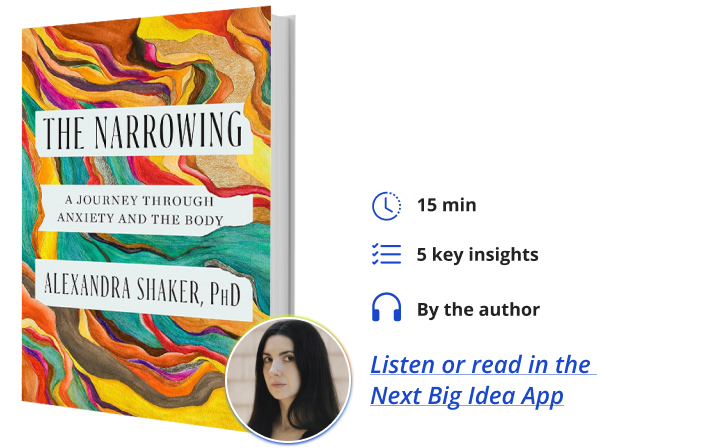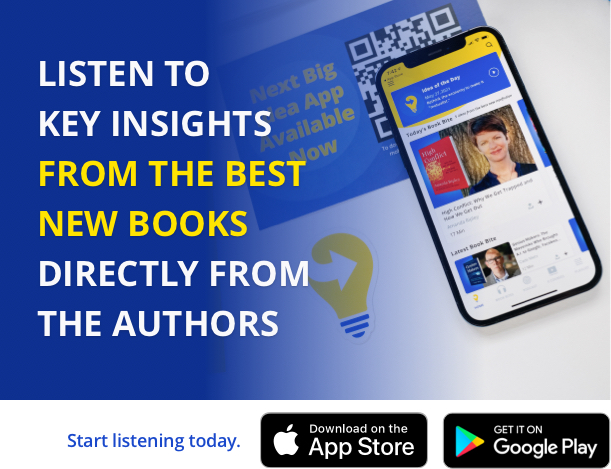Alexandra Shaker, PhD, is a licensed clinical psychologist with a background across inpatient and outpatient treatment settings. She has experience in research, teaching, and clinical practice. Dr. Shaker’s writing is an interdisciplinary exploration of the human condition: she integrates psychology, literature, history, anthropology, and language to speak to the meaning and vitality we find in the stories we tell one another and ourselves. Dr. Shaker received her PhD in clinical psychology from The New School for Social Research and conducted her doctoral research at the Brief Psychotherapy Research Program at Mount Sinai Beth Israel. She completed her clinical training at Columbia University Medical Center, and a postdoctoral fellowship in perinatal mental health at The Motherhood Center of New York, where she held a position as a clinical psychologist and is now a clinical consultant.
What’s the big idea?
Clinical psychologist Dr. Alexandra Shaker explores the deep connection between anxiety and the body, blending psychology, neuroscience, history, and literature. The Narrowing reveals how anxiety shapes not just our thoughts but our physical well-being—and how understanding this relationship can help transform fear into resilience. Through a journey from brain to gut, Dr. Shaker uncovers what our bodies can teach us about anxiety and why, despite scientific advancements, we still struggle with it. The Narrowing offers a fresh perspective on embracing anxiety as a natural part of being human—and using it to grow.
Below, Alexandra shares five key insights from her new book, The Narrowing: A Journey Through Anxiety and the Body. Listen to the audio version—read by Alexandra herself—in the Next Big Idea App.

1. Anxiety cannot be hacked.
When we are uncomfortable or in pain, it is natural to look for an escape route. In these moments, we want, more than anything, to change how we feel, through whatever means may appear quickest. When I recall moments in my life when I’ve felt particularly anxious, I recall, too, my overwhelming wish to flee the anxiety and all of its accompanying thoughts and physical sensations—the fear of having made a wrong decision, the blood rising to my face, and the sinking feeling in my gut.
In these vulnerable states, we can easily fall prey to claims of quick fixes—of, say, a diet that will (somehow) eliminate panic attacks, or a wearable device that will induce calm throughout the nervous system with the press of a button. We are living in a time when these so-called “cures” abound—most of all, on social media—and they are often difficult to resist. Their omnipresence is evidence of just how pervasive and troubling anxiety is. But the truth is, anxiety cannot be hacked. Depending on quick fixes inevitably ends in frustration and disappointment because, quite simply, they are not enough.
So, instead of looking for hacks to eliminate anxiety, we can instead think about approaching anxiety at two levels. We can learn to use strategies to manage anxiety initially, when it feels particularly overwhelming (like, for instance, breathing techniques and physical exercise), and then we can begin to look deeper. Treating anxiety in a meaningful, lasting way requires an appreciation for its depth—that is, for where it is coming from and for what it is trying to tell us. When we try to “hack” our way out of our distress, we miss an opportunity to learn from it.
2. Anxiety is a problem of attention.
Our attention is in constant demand, from the perpetual news cycle to workplace requirements to the seductive nature of social media platforms. Today, in a time of political upheaval, natural disasters, and devastating wars, our attention is newly stretched, even contorted. Despite our best intentions, many of us find ourselves struggling to harness our minds. Our time and energy seem in short supply, our focus is unwieldy, and we are anxious.
Anxiety and attention are intertwined aspects of our lives because anxiety is, in many ways, shaped by the movement of our attention. What is it that we pay attention to? Where do our minds linger or become stuck? We might find our minds drawn in many directions at once, or we might think about the same concern repeatedly. And then, what aren’t we paying attention to? This isn’t only a matter of staying on task or getting things done; it’s more profound. Our attention is finite, so when our minds are stuck in one place, it’s not just that we’re miserable, it’s that we miss out on paying attention to all sorts of other things—things about which we may feel curious or that might bring us joy.
“Although we can’t always control the movement of our attention, we can learn to have some sway over it.”
Research shows that anxiety is associated with heightened attention to threat. When we are anxious, we are particularly aware of potential threats in our environments (Bar-Haim et al., 2007). But we are not powerless. Research shows, too, that attention is a crucial aspect of our capacity for emotional regulation (Tan et al., 2023; Thayer & Lane, 2000; Wadlinger & Isaacowitz, 2011). So, the more we learn to modulate our attention, the more we can regulate our emotional states, especially the uncomfortable and even painful ones. Although we can’t always control the movement of our attention, we can learn to have some sway over it. The most widely known (and studied) method for developing greater control over one’s attention is consistent engagement in mindfulness practices.
Imagine how you might use your attention if you weren’t constantly moving between your work email and your phone and the news, or if you weren’t fixated on a conversation you had last week or a family matter about which you have no control. And then, imagine how you might feel as a result. Calmer, perhaps, more focused, and better able to appreciate the present moment. By learning to understand and shape the movement of our attention, we can make meaningful changes to our mental health.
3. Anxiety can be a powerful source of information.
Despite the reality that anxiety can be a source of frustration at best and suffering at worst, it is also a powerful source of information. Most of us have learned, in one way or another, to attempt to ignore our anxieties because they are a source of discomfort. But actually, anxiety can warn us of trouble ahead or compel us to look more closely at a situation we’re unsure of. And anxiety can teach us about ourselves and how we operate in the world and relate to others.
Many people live with chronic anxiety that manifests as thoughts and physical sensations without understanding its cause. When we notice anxious thoughts creeping in or the physical sensations of anxiety emerging—the sweaty palms, tightness in the jaw, and racing heart—instead of trying to distract ourselves from these uncomfortable sensations, we can ask ourselves what they might have to tell us. Perhaps there is a difficult family dynamic at play or an issue at work that seems to evoke anxiety every time. We can tune into our anxiety to learn from it instead of ignoring it. Our anxiety can teach us about what we are afraid of.
By learning what our anxiety has to teach us, by seeing it as a source of information, we no longer have to live by it. We can observe patterns in our thoughts and behaviors, and in doing so, we can gain greater control over our decisions instead of being ruled by feelings we haven’t made sense of. In this way, anxiety can become a teacher and a force for good.
4. We should all strive to widen our windows of tolerance.
We all have different responses to intense emotions and different levels of tolerance for distress. Over the course of our lives, these responses are etched into us, seemingly a facet of who we are.
For some people, a period of, for example, deep anger or exceptional stress seems to take over every thought and every action until it is resolved, whereas for others, these feelings can exist alongside other parts of life. Daniel Siegel, a psychiatrist who is also an expert on mindfulness, developed the term “window of tolerance.” He explains: “Each of us has a ‘window of tolerance’ in which various intensities of emotional arousal can be processed without disrupting the functioning of the system” (Siegel, 2020) That is, the wider our “window of tolerance,” the more we can experience intense emotions without feeling utterly consumed by them.
“When we learn to tolerate distress more effectively, we also become less susceptible to anxiety.”
The principle of the “window of tolerance” is often used in the context of research on and treatment for trauma, but it can also be applied to a range of other emotional experiences, including anxiety. Research has found that higher levels of distress tolerance are associated with lower levels of anxiety, and conversely, higher levels of anxiety are associated with lower levels of distress tolerance (Keough et al., 2010; Laposa et al., 2015). So, when we learn to tolerate distress more effectively, we also become less susceptible to anxiety.
Widening one’s window of tolerance isn’t a matter of feigning positivity or sweeping feelings under the rug. Instead, it requires acknowledging your emotional state, anxious or otherwise, and learning, over time, to tolerate the accompanying thoughts and sensations, even when they are uncomfortable.
Thankfully, our window of tolerance isn’t fixed; we aren’t simply born with a wide window of tolerance or not. We can increase or “widen” our tolerance with practices including mindfulness and other forms of distress tolerance that can be learned in psychotherapy and elsewhere. We can learn, over time, to better tolerate intense, often uncomfortable feelings (like anxiety) without being so thrown off. A stressor that may, in the past, have consumed your day might become a challenging but manageable part of it in the future. In this way, a wider window of tolerance can make our lives newly open to possibility.
5. Curiosity is a way through anxiety.
Anxiety narrows our minds. It creates tunnel vision, and it limits what we see. We know that anxiety is, in many ways, a problem of attention. So, when our attention feels overly fixed or rigid, or when we feel stuck in worry or doubt, we can tap into our curiosity as a way to move forward.
I find that curiosity, whether about our own experiences or the experiences of others, allows for gentle questioning rather than interrogation. Instead of berating ourselves with questions about, say, why we are anxious or ruminating about the same issue for hours, we can generate curiosity about how we feel and what is driving our feelings. We can wonder about our experience from an open perspective.
“Anxiety narrows our minds.”
Curiosity can open doors to new depths of understanding. We can see the power of curiosity in our relationship—for instance, how curiosity about other people’s perspectives can deepen our relationships. This holds true in the ways that we relate to ourselves, too.
We can see the importance of curiosity at play in a concept introduced by neuroscientist Lisa Feldman Barrett called “emotional granularity.” Emotional granularity refers to the degree of specificity with which we describe our feelings (Feldman Barrett, 2017). Even for the most of introspective people, it can be difficult to pin down our emotions with precision. We might say that we feel “anxious,” a nebulous term that reflects a wide range of experiences, and leave it at that, even in the privacy of our own thoughts. In these moments, we seem to hide in our words. We allow our emotional vocabulary to remain broad and general, as if in doing so, we won’t feel our pain so acutely.
But in fact, it’s quite the opposite. When we are curious, we can find relief in clarity. Imagine if, rather than telling yourself that what you feel is simply “anxious,” you homed in on something closer to its essence—that you feel stuck in a cycle of rumination, irritable, and hypervigilant.
Through curiosity, there is potential for profound understanding. When we are curious, we become open to new explanations and understandings, whether about our own internal life or the world around us. In this way, curiosity makes the world bigger rather than narrowing it down.
To listen to the audio version read by author Alexandra Shaker, download the Next Big Idea App today:































